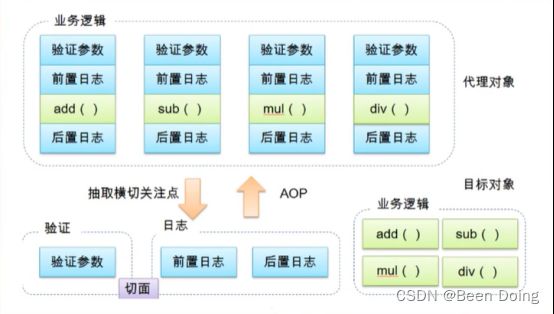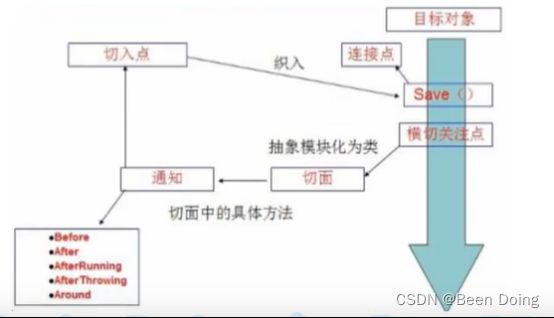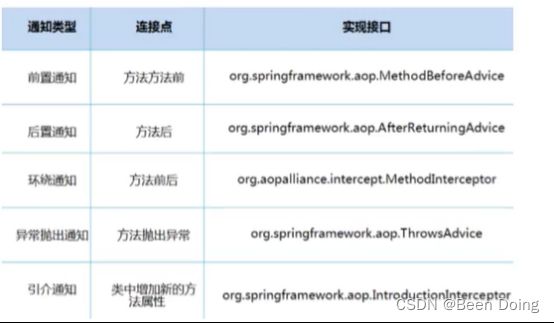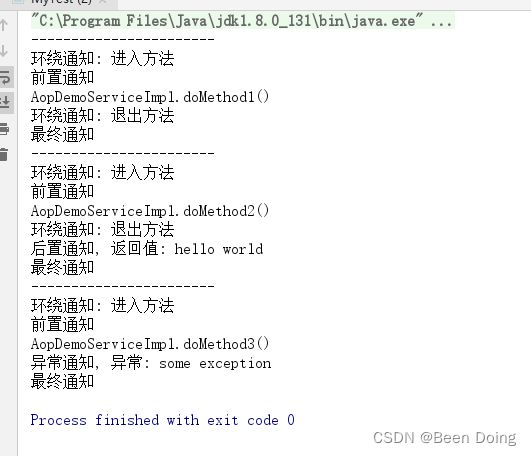AOP面向切面编程
AOP
什么是AOP
AOP (Aspect Oriented programming)意为:面向切面编程,通过预编译方式和运行期动态代理实现程序功能的统一维护的一种技术。AOP是OOP的延续,是软件开发中的一个热点,也是Spring框架中的一个重要内容,是函数式编程的一种衍生范型。利用AOP可以对业务逻辑的各个部分进行隔离,从而使得业务逻辑各部分之间的耦合度降低,提高程序的可重用性。

Aop在Spring中的作用:提供声明式的事务,允许用户自定义切面
- 横切关注点:跨越应用程序多个模块的方法或功能。即是,与我们业务逻辑无关的,但是 我们需要关注的部分,就是横切关注点。如日志,安全,缓存,事务等等…
- 切面(ASPECT): 横切关注点被模块化的特殊对象。即,它是一个类。
- 通知(Advice) : 切面必须要完成的工作。即,它是类中的一个方法。
- 目标(Target)︰被通知对象。
- 代理(Proxy): 向目标对象应用通知之后创建的对象。
- 切入点(PointCut): 切面通知执行的“地点"的定义。
- 连接点(JointPoint) : 与切入点匹配的执行点。

SpringAOP中,通过Advice定义横切逻辑,Spring中支持5种类型的Advice:

即Aop在不改变原有代码的情况下,去增加新的功能.
使用spring 实现AOP
使用AOP 注入,需要导入一个依赖包
<dependencies>
<dependency>
<groupId>org.aspectjgroupId>
<artifactId>aspectjweaverartifactId>
<version>1.9.4version>
dependency>
dependencies>
方式一:Spring API接口 【 主要SpingApi 接口实现】
1:UserService接口
public interface UserService {
public void add();
public void delete();
public void update();
public void select();
}
2:UserService的实现类
public class UserServiceImpl implements UserService{
@Override
public void add() {
System.out.println("增加了一个用户,");
}
@Override
public void delete() {
System.out.println("删除了一个用户,");
}
@Override
public void update() {
System.out.println("更新了一个用户,");
}
@Override
public void select() {
System.out.println("查询了一个用户,");
}
}
3:创建一个Log包,创建一个log的类
/**
* 第一种Spring AOP接口实现
*/
public class log implements MethodBeforeAdvice {
//method: 要执行的目标对象的方法
//args 参数
//target 目标对象
@Override
public void before(Method method, Object[] args, Object target) throws Throwable {
System.out.println(target.getClass().getName()+"的"+method.getName()+"方法被执行了。");
}
}
创建一个AfterLog的类
/**
* 第一种Spring AOP接口实现
*/
public class AfterLog implements AfterReturningAdvice {
//returnValue;返回值
@Override
public void afterReturning(Object returnValue, Method method, Object[] args, Object target) throws Throwable {
System.out.println("执行了"+method.getName()+"方法,返回结果为:"+returnValue);
}
}
4:配置Bean.xml文件,这里需要一个AOP的头文件
<bean id="userService" class="com.kuang.service.UserServiceImpl"/>
<bean id="log" class="com.kuang.log.log"/>
<bean id="after" class="com.kuang.log.AfterLog"/>
方式一: 使用原生Spring AOP 接口
<aop:config>
<aop:pointcut id="pointcut" expression="execution(* com.kuang.service.UserServiceImpl.*(..))"/>
<aop:advisor advice-ref="log" pointcut-ref="pointcut"/>
<aop:advisor advice-ref="after" pointcut-ref="pointcut"/>
aop:config>
头文件
<beans xmlns="http://www.springframework.org/schema/beans"
xmlns:xsi="http://www.w3.org/2001/XMLSchema-instance"
xmlns:aop="http://www.springframework.org/schema/aop"
xsi:schemaLocation="http://www.springframework.org/schema/beans
https://www.springframework.org/schema/beans/spring-beans.xsd
http://www.springframework.org/schema/aop
https://www.springframework.org/schema/aop/spring-aop.xsd">
beans>
方式二:自定义来实现AOP 【主要是切面定义】
/**
* 方式二:自定义来实现AOP
*/
public class DiyPointCut {
public void after(){
System.out.println("=======方法执行后========");
}
public void before(){
System.out.println("=======方法执行前========");
}
}
Bean.xml
<!--方式二:自定义类-->
<bean id="diy" class="com.kuang.diy.DiyPointCut"/>
<aop:config>
<!--自定义切面,要引用的类-->
<aop:aspect ref="diy">
<!--切入点-->
<aop:pointcut id="pointcut" expression="execution(* com.kuang.service.UserServiceImpl.*(..))"/>
<!--通知-->
<aop:after method="after" pointcut-ref="pointcut"/>
<aop:before method="before" pointcut-ref="pointcut"/>
</aop:aspect>
</aop:config>
测试:
public class MyTest {
public static void main(String[] args) {
ApplicationContext context = new ClassPathXmlApplicationContext("applicationContext.xml");
//动态代理是接口
UserService userService = (UserService) context.getBean("userService");
userService.add();
}
}
方式三:使用注解实现【】
/**
* 第三种注解实现AOP
*/
@Aspect //标注这个类直接是切面
public class AnnotationpiontCut {
@After("execution(* com.kuang.service.UserServiceImpl.*(..))")
public void after(){
System.out.println("=======方法执行后========");
}
@Before("execution(* com.kuang.service.UserServiceImpl.*(..))")
public void before(){
System.out.println("=======方法执行前========");
}
Bean.xml
<!--方式三-->
<bean id="annotationpiontCut" class="com.kuang.diy.AnnotationpiontCut"/>
<!--开启注解支持-->
<aop:aspectj-autoproxy/>
测试类:
ApplicationContext context = new ClassPathXmlApplicationContext("applicationContext.xml");
//切入点;
UserService userService = context.getBean("userService", UserService.class);
userService.add();
测试OK;
目标对象;
package com.kuang.service;
//目标对象
public class AopDemoServiceImpl {
public void doMethod1() {
System.out.println("AopDemoServiceImpl.doMethod1()");
}
public String doMethod2() {
System.out.println("AopDemoServiceImpl.doMethod2()");
return "hello world";
}
public String doMethod3() throws Exception {
System.out.println("AopDemoServiceImpl.doMethod3()");
throw new Exception("some exception");
}
}
通知
package com.kuang.service;
//目标对象
public class AopDemoServiceImpl {
public void doMethod1() {
System.out.println("AopDemoServiceImpl.doMethod1()");
}
public String doMethod2() {
System.out.println("AopDemoServiceImpl.doMethod2()");
return "hello world";
}
public String doMethod3() throws Exception {
System.out.println("AopDemoServiceImpl.doMethod3()");
throw new Exception("some exception");
}
}
配置切入,开启注解支持
<beans xmlns="http://www.springframework.org/schema/beans"
xmlns:xsi="http://www.w3.org/2001/XMLSchema-instance"
xmlns:aop="http://www.springframework.org/schema/aop"
xsi:schemaLocation="http://www.springframework.org/schema/beans
https://www.springframework.org/schema/beans/spring-beans.xsd
http://www.springframework.org/schema/aop
https://www.springframework.org/schema/aop/spring-aop.xsd">
<aop:aspectj-autoproxy/>
<bean id="aopDemoServiceImpl" class="com.kuang.service.AopDemoServiceImpl">
bean>
<bean id="logAspect" class="com.kuang.log.LogAspect">
bean>
<aop:config>
<aop:aspect ref="logAspect">
<aop:pointcut id="pointCutMethod" expression="execution(* com.kuang.service.*.*(..))"/>
<aop:around method="doAround" pointcut-ref="pointCutMethod"/>
<aop:before method="doBefore" pointcut-ref="pointCutMethod"/>
<aop:after-returning method="doAfterReturning" pointcut-ref="pointCutMethod" returning="result"/>
<aop:after-throwing method="doAfterThrowing" pointcut-ref="pointCutMethod" throwing="e"/>
<aop:after method="doAfter" pointcut-ref="pointCutMethod"/>
aop:aspect>
aop:config>
beans>
测试:
import com.kuang.service.AopDemoServiceImpl;
import com.kuang.service.UserService;
import org.springframework.context.ApplicationContext;
import org.springframework.context.support.ClassPathXmlApplicationContext;
public class MyTest {
public static void main(String[] args) {
ApplicationContext context = new ClassPathXmlApplicationContext("applicationContext.xml");
//动态代理是接口
AopDemoServiceImpl aopDemoServiceImpl = (AopDemoServiceImpl) context.getBean("aopDemoServiceImpl");
aopDemoServiceImpl.doMethod1();
aopDemoServiceImpl.doMethod2();
try {
aopDemoServiceImpl.doMethod3();
} catch (Exception e) {
// e.printStackTrace();
}
}
}



